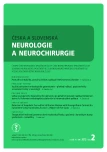Obstructive Sleep Apnoe and CPAP – is it Reasonable to Solve Nasal Patency?
Authors:
T. Pniak 1; Petr Matoušek 1
; P. Štrympl 1; V. Novák 2; Pavel Komínek 1
Authors‘ workplace:
Fakultní nemocnice Ostrava
ORL klinika
1; Fakultní nemocnice Ostrava
Klinika dětské neurologie
2
Published in:
Cesk Slov Neurol N 2012; 75/108(2): 222-226
Category:
Short Communication
Overview
Objective:
The purpose of this paper was to evaluate the effect of septoplasty and turbinoplasty in the treatment of obstructive sleep apnoe (OSA), also including evaluation of subsequent CPAP (Continuous Positive Airway Pressure) therapy.
Material and methods:
Authors present a sample of 28 patients with reduced nasal patency and OSA. Nasal septal deviation and inferior turbinate hypertrophy identified by rhinoendoscopy in all these patients was corrected surgically. Pre - and postoperatively, rhinomanometry and limited polygraphy with a special emphasis on AHI (Apnoe/Hypopnoe Index) were obtained. Subjective outcome and daytime sleepiness were also evaluated. Nasal CPAP trial was performed in patients with persistent moderate to severe postsurgical OSA, specifically focusing on therapy tolerance.
Findings:
An improvement in subjective nasal patency was observed in 27 patients, while daytime sleepiness did not improve. There was no significant postoperative decrease in AHI (p = 0.0792). CPAP was accepted in 3 of 8 indicated patients.
Conclusion:
Even though there was subjective and objective improvement of nasal patency after the operation, no significant improvement of ventilation parameters was observed. Positive effect of nasal surgery on CPAP tolerance was not confirmed in our cohort.
Key words:
septoplasty – obstructive sleep apnoe – rhinomanometry
Sources
1. Kountakis S, Őnerci M. Rhinologic and Sleep Apnea Surgical Techniques. Berlin Heidelberg: Springer 2007 : 255–378.
2. Nevšímalová S, Šonka K. Poruchy spánku a bdění. 2nd ed. Praha: Galén 2007.
3. Plzák J, Klozar J, Betka J. Obstrukční syndrom spánkové apnoe: diagnóza a léčba. Otorinolaryngolog Foniat 2002; 51(4): 216–220.
4. Zonato AI, Bittencourt LR, Martinho FL, Gregório LC, Tuffik S. Upper airway surgery: the effect on nasal continuous positive airway pressure titration on obstructive sleep apnea patiens. Eur Arch Otorhinolaryngol 2006; 263(5): 481–486.
5. Sugiura T, Noda A, Nakata S, Yasuda Y, Soga T, Miyata S et al. Influence of nasal resistance on initial acceptance of continuous positive airway pressure in treatment of obstructive sleep apnea syndrome. Respiration 2007; 74(1): 56–60.
6. Kimoff RJ, Sforza E, Champagne V, Ofiara L, Gendron D. Upper airway sensation in snoring and obstructive sleep Apnea. Am J Respir Crit Care Med 2001; 164(2): 250–255.
7. Fairbanks DN. Effect of nasal surgery in the management of sleep apnea. Ann Otorinolaryngol 1985; 94 : 550–554.
8. Li, H, Lee L, Wang P, Chen N, Lin Y, Fang T. Nasal surgery for snoring in patients with obstructive sleep apnea. Laryngoscope 2008; 118(2): 354–359.
9. Li H, Lin Y, Chen N, Lee LA, Fang TJ, Wang PC. Improvement in quality of life after nasal surgery alone for patients with obstructive sleep apnea and nasal obstruction. Arch Otolaryngol Head Neck Surg 2008; 134(4): 429–433.
10. Verse T, Maurer JT, Pirsing W. Effect of nasal surgery on sleep related breathing disorders. Laryngoscope 2002; 112(1): 64–68.
11. Virkkula P, Bachour A, Hytönen M, Salmi T, Malmberg H, Hurmerinta K et al. Snoring Is Not Relieved by Nasal Surgery Despite Improvement in Nasal Resistence. Chest 2006; 129(1): 81–87.
12. Sher AE, Schechtman KB, Piccirillo JF. The efficacy of surgical modifications of the upper airway in adult with obstructive sleep apnea syndrome. Sleep 1996; 19(2): 157–177.
13. Kuchynková Z, Andrle J, Vrabec P. Rinomanometrie v indikaci a hodnocení výsledků septoplastik. Otorinolaryngol Foniat 1998; 47(1): 40–43.
14. Masdon JL, Magnuson JS, Youngblood G. The effect of upper airway surgery for obstructive sleep apnea on nasal continuous positive airway pressure settings. Laryngoscope 2004; 114(2): 205–207.
15. Friedman M, Tanyeri H, Lim JW, Landsberg R, Vaidyanathan K, Caldarelli D. Effect of improved nasal breathing on obstructive sleep apnea. Otolaryngol Head Neck Surg 2000; 122(1): 71–74.
16. Woodson B. Predicting which patients will benefit from surgery for obstructive sleep apnea: The ENT exam. Ear Nose Throat J 1999; 78(10): 792–800.
Labels
Paediatric neurology Neurosurgery NeurologyArticle was published in
Czech and Slovak Neurology and Neurosurgery

2012 Issue 2
Most read in this issue
- The Use of Percutaneous Endoscopic Gastrostomy – Overview of Indications, Description of the Technique and Current Trends in Neurology
- Postural Instability, Gait Disorders and Falls in Parkinson’s Disease
- The Algorithm of CSF Examination according to the Reccomendation of the Committee of CSF and Neuroimmunology of the Czech Neurological Society
- Obstructive Sleep Apnoe and CPAP – is it Reasonable to Solve Nasal Patency?
